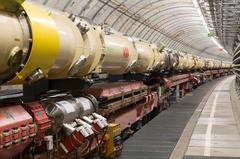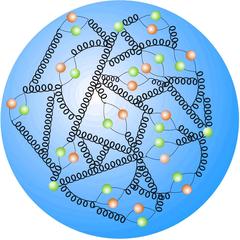The HERA accelerator tunnel (photo: DESY/T. Zoufal).
The two HERA collaborations H1 and ZEUS have combined their measurements on heavy quark production. The paper which is now published by The European Physics Journal summarises an analysis of charm and beauty quark production in these collisions. A team led by DESY physicists has produced final results, a culmination of over 20 years of work. Together with previously published physics results from HERA, it will appear in text books of the future as well as having application to the physics studied at the Large Hadron Collider in CERN, Geneva to which DESY groups also make key contributions.
From 1992 to 2007, the unique 6.3-kilometre underground storage ring HERA (Hadron Electron Ring Accelerator) at DESY collided electrons and protons accelerated close to the speed of light in order to resolve and study the proton's structure. Protons are in the core of each single atomic nucleus in the universe. Their composition of three quarks – two up and one down quark which are held together by so-called gluons, carrier particles of the strong force, is well known since decades. However, HERA showed a much more complicated picture of the proton: a sizzling soup where gluons can produce more gluons and can split into pairs of quarks and antiquarks – the so-called sea quarks – all of them interacting again very quickly.Therefore electrons were used as probes which penetrated deeply into the proton and were scattered off one of the proton’s constituents via exchange of the weak or the electromagnetic force, two of the four basic forces in the universe. The particles emerging from the scattering processes – some of them so-called heavy quarks called charm and beauty – were measured by the two multi-purpose detectors H1 and ZEUS.
Compared to the up and down quarks, charm and beauty quarks are about 1000 times heavier. Consequently, they were produced less frequently in electron-proton interactions. In order to have the highest precision possible, the two collaborations have recently combined all their measurements on the production of these heavy quarks. The detailed analysis allows precision tests of the theory of the strong force, quantum chromodynamics (QCD), and to constrain the structure of matter. The measurements have also been used to provide extractions of the masses of the charm and beauty quarks. DESY physicist Oleksandr Zenaiev, who led the analysis, comments: “The masses are two of the fundamental parameters of the Standard Model of particle physics and have been measured here to high precision.” The results compare well with other measurements in different processes, demonstrating the universality of the measurements.
Joachim Mnich, DESY´s Director in charge of Particle and Astroparticle Physics, notes: “The HERA experiments have collected a very valuable set of lepton-proton collisions and continue to produce high-level publications even 10 years after the end of data taking. The publication is also a substantial proof that our efforts to preserve the HERA data for later analysis pays off.”
Overall, the theoretical calculations, based on QCD, give a reasonable description of the data. “However, some tension is observed when simultaneously trying to describe these measurements of heavy quark production and similar inclusive measurements where no requirement on the nature of the quark is imposed. This demonstrates that HERA data are still challenging our best theoretical descriptions of the fundamental structure of matter. The collaborations look forward to further theoretical developments inspired by these unique results”, says Matthew Wing, spokesman of the ZEUS collaboration.
Reference:
Combination and QCD analysis of charm and beauty production cross-section measurements in deep inelastic ep scattering at HERA; Abramowicz, H., Abt, I., Adamczyk, L. et al.; The European Physics Journal, 2018; DOI: 10.1140/epjc/s10052-018-5848-3









